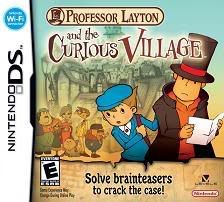 Professor Layton and the Curious Village
Professor Layton and the Curious Village
Developer: Level 5
Publisher: Nintendo
Genre: Adventure
Release Date 2/10/08
Professor Layton showed up to my house unexpected Friday evening, along with a giant foam top hat and a black leather note pad from Nintendo. Interesting swag, don’t you think? I wasn’t expecting to review this, as Chuck and Jack are going to be reviewing it for the launch of Diehard GameFAN, but I figure we have some time before that, so why not review it myself? That way Nintendo gets three full length descriptive reviews, unlike say from EGM, who gives three paragraphs. Ooh! INFORMATION OVERLOAD.
I finished the game in ten hours and change with 118 puzzles found and solved. There are a little over 130 puzzles in the game, so I think I did okay. This is the first in a trilogy of story based puzzle games coming from Level 5 featuring Professor Layton, and the second was released in Nov., 2007.
I hesitate to put this game under the Adventure category, as it’s not really a point and click game, but it features so many aspects from the genre like static graphics, a game that is plot driven but advanced only by solving puzzles that sometimes have nothing to do with the game itself, and a lot of backtracking through a singular location, that I can’t really call it a straight puzzle game like Brain Age or Columnsa.
So is Professor Layton and the Curious Village a successful start to this new franchise being put out by Level Five, or was the game only good for a wacky new hat for my friends and I to joke about wearing to raves?
Let’s Review
1. Story
Professor Layton and the Curious Village pretty much gives you the plot in its title. At least on the surface. Layton and his annoying sidekick, Luke travel the to village of St. Mystere after its Baron passes away. They are called in to solve the mystery of the “Golden Apple.” From there things get weird as everyone in the city seemed to have puzzle after puzzle under their belt for you to solve.
It’s an interesting idea to have a Big Brain Academy game with the puzzles interwoven by a neat little mystery tale, but only two puzzles in the game actually have anything to do with the plot, so it you’re constantly taken out of the story aspect to solve puzzles. It’s not jarring, but it does greatly reduce your ability to suspend disbelief.
The story is nicely crafted, but it is very cliché. I know I’ve heard this plot before on several occasions. I figured out the two big spoilers, one about the detective and the other about the town, less than halfway through the game and I was VERY disappointed to see them come to pass. Not necessarily because they were so predictable, but because those outcomes were so AWFUL.
I also understand them purposely leaving plot points unresolved, like the arch villain Don Paulo, but nothing ruins a serious game more than when the sidekick goes, “Why is he your arch enemy?” and the hero responds, “I have no idea.” I’m sure we’ll find out in the later games, but that was a pretty lame cop out to me to just have this guy decide to start arching Professor Layton. This sort of thing works in comedy ala the Monarch and Dr. Venture, but it left me cold here.
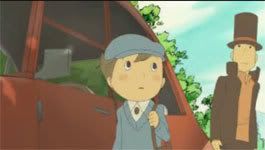 Normally I would complain about how two-dimensional the supporting cast in the game is, but unlike a lot of games, there is a reason for this, so I’ll let it pass.
Normally I would complain about how two-dimensional the supporting cast in the game is, but unlike a lot of games, there is a reason for this, so I’ll let it pass.
Even though I found the story predictable and inane at times, I did enjoy the ending, which again, is pretty transparent. It was sweet and yet melancholy at the same time, and it left me a little sad. Considering I’m pretty emotionally unattached to every video game I play, this surprised me, but it shows they did something right to make me feel for some of the characters after the bitching I did in the above paragraphs.
In all, I think the story would have worked better as an animated movie. It’s a nice little story that should appeal to kids and I enjoyed Professor Layton as a character, even if I wanted to push Luke in front of a bus. He’s worse than Short Round. I think the actual gameplay and puzzles however detract from the story because of the disconnect between the two. I’m sure some people will say that the puzzles are geared for adults while the story is geared for kids, but I disagree on that. The story is sweet and intriguing, so all ages can appreciate it. I just wish they had gone with something a little more original, rather than take something that has been done before in several other adventure games and give it a face lift plot-wise. Still, for people new to adventure games or brain teasers, this story just might be what it takes to hook them.
Story Rating: 5/10
2. Graphics
The visuals of Professor Layton remind me a lot of Studio Ghibli films. The characters look like they came from movies like Kiki’s Delivery Service or Princess Mononoke. A lot of the graphics, due to the adventure/puzzle nature of the game are static, which may turn a lot of gamers off, but I’m used to it as I’m a fan of the genre. I personally loved the character designs of everyone in the village, and can’t think of anything bad to say about them.
I was also impressed by the cinematic cut scenes in the game. They were highly impressive compared to what I’ve seen the DS do previously, and it continued to capture that animated film feeling.
I think more action oriented gamers will be put off by the lack of motion and animation in the game’s graphics, but for fans of sheer aesthetic beauty, Professor Layton will definitely charm you. The backgrounds, characters, and even the puzzle designs are well superb.
Graphics Rating: 8/10
3. Sound
Here is where we start to see the quality of the game take a nose dive. Most of the voice acting is horrendous. Aside from Professor Layton and Don Paulo, I pretty much hated every character. I swear, if I ever hear Luke’s voice again, I will probably scream. Maybe it’s because I used to claim residency in the United Kingdom, but there is nothing more annoying to me that really poorly done British accents.
I was not a fan of the music either. On rare occasion there was a decent song, but the most prevalent ones that you will here are also the most annoying. These include the general “Walking around town” theme and worst of all the, “Music playing while you are doing a puzzle” tune. Man, I HATED that one. Music should either enhance a game or be barely noticeable while you are concentrating at the task you are trying to perform. Not here though. The tune is both annoying and distracting. It’s like going to a bad piano recital.
As much as I loved the visuals of Professor Layton, the aural experience was pretty poor. I found in retrospect, when I had unlocked the sound test, that there were some nice little tracks in the game, but they played so rarely, you couldn’t really appreciate them. That and their quality was overshadowed by the awfulness of the other tracks and the really bad voice acting.
Sound Rating: 4/10
4. Control and Gameplay
On one hand, Adventure games have not faired well on the DS. Myst for example was once the most popular Adventure game ever, while the DS port is ridiculed for horrible movement/action detection on the touch pad. On the other hand, both Brain Age games are in the top five best selling titles for the DS, which implies excellence.
I’m sad to inform you that while the puzzles come from the Brain Age style of gaming, Professor Layton has some serious detection issues.
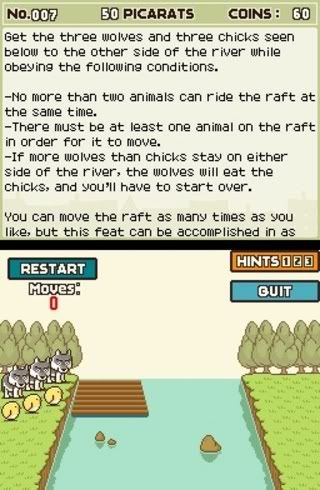 The big problem I found is the game’s ability to read numbers or letters. 4 and 9 were the numbers it had the most problems with. Letters like A-H and K gave it difficulty as well. I have no idea why it kept reading my A as X, but it did with an alarming frequency. This made me pretty annoyed at times, and hopefully FUTURE games from this franchise will give you a mini keyboard to pull up and select letters from as a backup.
The big problem I found is the game’s ability to read numbers or letters. 4 and 9 were the numbers it had the most problems with. Letters like A-H and K gave it difficulty as well. I have no idea why it kept reading my A as X, but it did with an alarming frequency. This made me pretty annoyed at times, and hopefully FUTURE games from this franchise will give you a mini keyboard to pull up and select letters from as a backup.
There was also some issues when it came to the game being extra picky. One puzzle you will find in the dark tower will involve tracing an arrow out of all the lines on this board. Finding the arrow wasn’t so bad, but tracing it was a bitch. The game does, in its’ defense warn you that you need to trace the line pretty straight, but you really did need to be exact and not even go off the arrow for a millimeter. Again, frustrating, and it makes me wonder how little kids, or people with Parkinson’s/Arthritis will do on this puzzle, especially as it’s one you NEED to do to advance the end plot.
Most of the game is just walking through the village and solving puzzles. Eventually you’ll find someone with a puzzle who advances the plot, and then you move on to solve MORE puzzles. There’s not really much there in the way of controls.
Puzzles can be broken into five categories. The first are standard puzzles, which come in a variety of forms and are what the villagers offer you. The second are hidden puzzles, which you can only find by exploring and tapping things with your stylus. These puzzles will generally offer you more Picarats (points) than normal puzzles, but they tend to be easier as well. The third are what I call “Mega-Puzzles,” which are puzzles that you earn pieces to by solving OTHER puzzles. One involves putting together a robot dog, another a painting and the third are arranging objects between Luke and Layton’s rooms to make them feel cozy and happy. Solving the “Mega-Puzzles” earns you a fourth type of puzzle which are Layton’s bonus puzzles that can be solved outside of the normal game. These are the hardest puzzles in the game, but are also amongst the most fun. The final type of puzzle are the downloadable ones. Once a week, you can get a new puzzle for your DS via the Wi-Fi connection. This a great little idea that will keep fans of this game coming back for more.
There’s a lot of variety here, but it also comes with some serious stylus/detection issues. The game involves a lot of backtracking I just didn’t have fun navigating through the game, or even playing it for that matter. The interaction with the touch pad really left a lot to be desired on games where it needed to be pretty spot on, like with making squares on a peg board, or having to write out entire words.
Control and Gameplay Rating: 4/10
5. Replayability
Although Professor Layton is a VERY linear game, it is still possible to miss puzzles. If this ever happens, you can just go to “Granny’s House” and find the puzzles you missed there. This means the game doesn’t punish you for missing any puzzles, and if you just want to streamline through the plot, you can do so, then return to do the other puzzles later.
The unlockable bonus content and the Mega-Puzzles add a lot to the replayability of the game as well. It’s nice to see some extras that you don’t have to do, which a lot of adventure games lack.
The downloadable content also makes Professor Layton worth coming back to. A new puzzle every week for six months? That’s one of the best uses of the DS wi-fi connection I’ve ever seen.
Finally, There’s something in the unlockables that you will only be able to achieve by getting a password from the SECOND game, which of course, has not been released as of yet in the US. This means people will come back to the first game in the series and hopefully find something new and exciting to rekindle their interest.
Professor Layton and the Curious Village offers an amazing amount of replay for a puzzle/adventure game hybrid. This will no doubt be one of the huge selling points for the title.
Replayabiliity Rating: 7/10
6. Balance
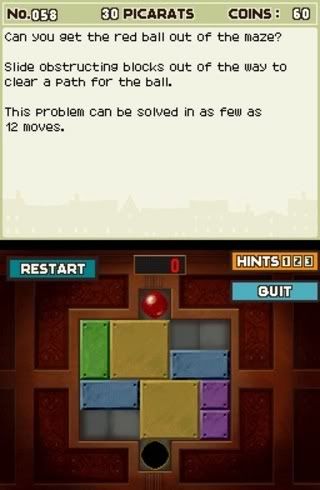 There really isn’t any balance to this game. Some puzzles are exceptionally easy, while others are quite difficult. There is no rhyme or reason, or even a sliding scale of difficulty in the game. It’s just all over the place. The problem then becomes that the game will frustrate younger gamers and possible bore older ones who will have seen MANY of these brain teasers in books and puzzle collections, or even other games many times before. I remember several of these puzzles from Elementary school for example, which made me very disappointed in the game after the manual made SUCH a big deal about original puzzles being made for it.
There really isn’t any balance to this game. Some puzzles are exceptionally easy, while others are quite difficult. There is no rhyme or reason, or even a sliding scale of difficulty in the game. It’s just all over the place. The problem then becomes that the game will frustrate younger gamers and possible bore older ones who will have seen MANY of these brain teasers in books and puzzle collections, or even other games many times before. I remember several of these puzzles from Elementary school for example, which made me very disappointed in the game after the manual made SUCH a big deal about original puzzles being made for it.
I also found a few (not many but still,) puzzles to be poorly described, or worse, ones where the answers still did make any logical sense, even after the reason for the correct answer was described. Again, this was a tiny percentage of the puzzles, but they were still in the game.
It’s hard to judge balance on here simply because all of our brains work so differently. Some of us, like myself might find word puzzles exceptionally easy, but then have trouble with the optical illusion puzzles.
In all though, I found the puzzles pretty easy. 118 puzzles in 10 hours equals 11.8 puzzles in one hour which equals a hair under six puzzles in 30 minutes which equals one puzzle solved every five minutes. Factor in story and investigating and that means I breezed through this game like nobody’s business.
I can’t in good conscience give this game high marks here due to control issues, the lack of originality with a few of these puzzles, and the ease I had with the game. At the same time I can see other people getting really frustrated with this game, especially younger gamers. Hell, there were times I got frustrated, and I ended the game will well over 4500 picarats. My honest opinion is that the game is poor here as well, and I’d be a bad reviewer if I said otherwise.
Balance rating: 4/10
7. Originality
Cliche plot I’ve seen before? Check? Puzzles I’ve done before even if I really enjoyed them like the sliding block or queen/chessboard puzzles? Check.
What saves the game here are a few puzzles like the chocolate keyboard puzzle, which was highly original and a lot of fun (It’s also a North American exclusive puzzle), and the level of charm with which the game oozes.
I hope the next game offers a lot more in terms of original puzzles and plot though. It’s a pretty game to be sure, but the lack of anything innovative really made getting through the game a chore for me at times.
Originality Rating: 5/10
8. Addictiveness
Although there were times where I was bored and disappointed with Professor Layton and the Curious Village, it was pretty easy to lose myself in it. I’d solve puzzle after puzzle and then be surprised how LITTLE time had passed. Most games you tend to have time fly by. With Professor Layton, time slooooooooooowed way down. You might think this implies boredom or some manner of negative connotation, but in fact it shows how much effort and thought I was putting into the game. Generally when I do analytical puzzles, my brain leaps into hyperdrive thought process wise where I’m also thinking time is passing much faster than it really is. This is how I aced the Analytical section of the GRE with half the time still on the clock. I haven’t been that “in the zone” since, but Professor Layton is the closest I’m come in six years to that mindset. I find that impressive.
In retrospect though, as deep as I delved into the game, I think beating the entire game in a two day span was probably a bad thing. Professor Layton is a game that should be played for short periods over a long span of time. Playing it in a “too much, too soon” manner just made me want to be done with the game halfway in instead of taking my time and enjoying what it had to offer.
If you’re a puzzle or adventure game fan, I can see you having a lot of fun with this. Even with my issues with Professor Layton, I still got sucked in.
Addictiveness Rating: 7/10
9. Appeal Factor
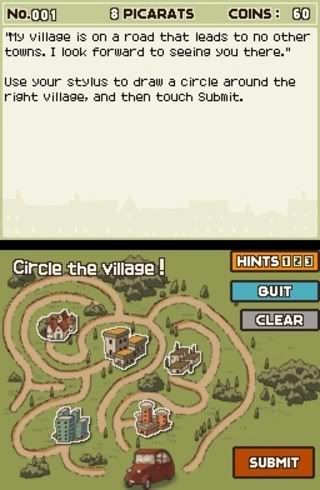 As the Brain Age games have shown a lot of appeal to DS owners, no doubt those same people will pick up Professor Layton, if only because they’re looking for a similar game, or are intrigued by the story aspect of the game. At the same time, the story might drive away those who just want a straight puzzle minded game, and the puzzles themselves may frustrate the core Nintendo fanbase. Even Adventure gamers might be annoyed by the fact the puzzles have a distinct lack of in-story connection, as I was. This is a definite departure for the genre, and it left me cold. Even with those potential cast-offs, the Brain Age audience is huge, and that means with proper marketing, Professor Layton will sell like hotcakes.
As the Brain Age games have shown a lot of appeal to DS owners, no doubt those same people will pick up Professor Layton, if only because they’re looking for a similar game, or are intrigued by the story aspect of the game. At the same time, the story might drive away those who just want a straight puzzle minded game, and the puzzles themselves may frustrate the core Nintendo fanbase. Even Adventure gamers might be annoyed by the fact the puzzles have a distinct lack of in-story connection, as I was. This is a definite departure for the genre, and it left me cold. Even with those potential cast-offs, the Brain Age audience is huge, and that means with proper marketing, Professor Layton will sell like hotcakes.
I do hope the first game succeeds though, as I would love to see a sequel with the same team and characters, but with some more original thought put into the project.
Appeal Factor: 6/10.
10. Miscellaneous
Although Professor Layton‘s first outing was certainly filled with stumbling, recognition issues and some pretty bad music, there is a lot packed into this title for the avid puzzle gamer. The “Mega-Puzzles”, unlockable art, music, video, and biography galleries were a fun touch as well. So many Adventure games lack any extras, so getting this was a welcome treat. I loved the wi-fi connectivity, and I am quite interested to see how/if the puzzles improve over the coming weeks.
Although I can’t recommend Professor Layton and the Curious Village to any but the most ardent puzzle gamers, I do look forward to the sequel as the groundwork for what may someday be an excellent adventure game series has been laid.
Miscellaneous Rating: 6/10
The Scores
Story: MEDIOCRE
Graphics: GREAT
Sound: POOR
Control and Gameplay: POOR
Replayability: GOOD
Balance: POOR
Originality: MEDIOCRE
Addictiveness: GOOD
Appeal Factor: ABOVE AVERAGE
Miscellaneous: ABOVE AVERAGE
FINAL SCORE: ABOVE AVERAGE
Short Attention Span Summary
For puzzle game fanatics only. Every one else, think long and hard before buying. The game has its charms, but charm alone does not make for a rewarding gaming experience.